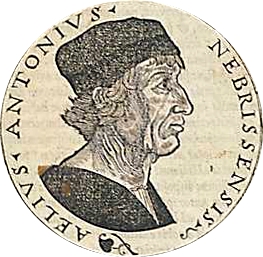
Word of the Day: Benign
Benign is an adjective meaning “mild or favorable (result). Gentle, kind, good.” It is often used in relation to medical cases, like “The tumor was benign.” According to www.etymonline.com, the word entered English in the 14th century from Old French “benigne ‘kind, benign, merciful, gracious’ (12c., Modern French bénin, fem. bénigne), from Latin benignus ‘kindly, kindhearted, friendly, generous,’ literally ‘well born,’ from bene ‘well’ (see bene-) + gignere ‘to bear, beget,’ from genus ‘birth’ (from PIE root *gene- ‘give birth, beget’).” The French origin explains the spelling, with the silent g, because French is even more notorious for silent letters than English.
1492 was a special year for Spain. In that year, of course, Queen Isabella and King Ferdinand, sponsored Christopher Columbus’s trip to the East Indies that actually led to the “discovery” of the New World. 1492 was also the year when Ferdinand and Isabella’s ten-year war against the Kingdom of Granada ended with the Christians driving the Muslims off of the Iberian Peninsula. Finally, on this day in 1492, Isabella was presented with the first grammar of a vernacular language.
“In the history of Spanish, it’s hard to imagine a character more important than Antonio de Nebrija. In the 15th century, Nebrija wrote the first veritable ‘grammar’ of Spanish and made Spanish the first vernacular Latin language to be defined. He then went on to write the most complete Spanish dictionary to date. Both were published at the end of July, 1492.
“Born Antonio Martínez de Cala y Jarava between 1441 and 1444, near Seville, Nebrija later adopted the name of his hometown, Nebrixa (now spelled Lebrija).
“Nebrija’s Castilian Grammar was actually a bit of an accident. The scholar’s real passion was for Latin. Discouraged by the deteriorating teaching standards of Latin in Spain at the time, he set out raise them by writing a Latin grammar all Spaniards could use. The problem? Soon after publishing the Latin Grammar, he realized that to get more Spaniards to read it, he needed to translate his work into Spanish.
“In 1492, just before Columbus set sail for the New World, Nebrija published the Gramática de la lengua castellana. Latin and Greek were the teaching languages at the time and most people didn’t even think Castilian had a grammar. It turned out that Spanish did have a grammar.”
When reading the above, you have to keep in mind that the language of scholarship, the language of learning, was Latin. It was also the language of the Church. Studying a vernacular tongue was not considered scholarly at all, though writing in the vernacular was becoming more popular throughout Europe. Today, of course, Latin is a dead language studied by fewer and fewer people, whereas over 400 million people speak Spanish.
There is a story that, when first presented with the first Spanish grammar, Queen Isabella questioned the value of such a work. The response was delivered by the Bishop of Avila, who said, “After Your Highness has subjected barbarous peoples and nations of varied tongues, with conquest will come the need for them to accept the laws that the conqueror imposes on the conquered, and among them our language; with this work of mine, they will be able to learn it, as we now learn Latin from the Latin Grammar.” That’s not exactly a benign reason for developing a grammar, at least from a modern perspective, but it began a trend that continues to this day.